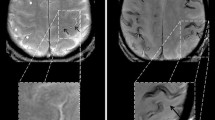Abstract
Subarachnoid hemorrhage extension (SAHE) in the acute phase of cerebral amyloid angiopathy (CAA)-related lobar hemorrhage (LH) assessed by CT is very frequent. Recently, SAHE, together with finger-like projections on CT and ApoE4, has been used in a prediction model for histopathologically proven CAA showing excellent discrimination. Our aim was to analyze SAHE on MRI in the acute and subacute phase of LH in patients with and without associated hemorrhagic features supportive of CAA (i.e. chronic LH, cortical superficial siderosis [CSS], and strictly lobar cerebral microbleeds [CMB]). We retrospectively studied SAHE on MRI performed in the acute and subacute phase (within 21 days) in a cohort of consecutive patients with acute LH recruited between January 2012 and April 2018. Sixty-eight acute LH patients (35 men and 33 women, mean age 74 [range 50–89]) were analyzed. Mean delay between symptom onset and MRI was 3.8 days, and 32 patients underwent MRI within 24 h. Based on MRI, 51 patients were classified as probable CAA and 17 patients without probable CAA. Both groups were comparable regarding age, sex, time of MRI performance, MRI field strength, and acute LH volume. Overall, SAHE was observed in 46 (68%) patients, including 39 (76%) patients with probable CAA and 7 (41%) patients without probable CAA (p = 0.015). SAHE presence was also associated with larger LH volumes. During the work-up in the acute/subacute phase of patients with acute LH, in addition to T2*-weighted imaging in search for other hemorrhagic features (chronic LH, CSS, or lobar CMB) evoking probable underlying CAA etiology, search for SAHE on adapted MRI sequences (FLAIR and T2*-weighted imaging) seems to be interesting because of the association with the presence of probable CAA criteria.

Similar content being viewed by others
References
Charidimou A, Imaizumi T, Moulin S et al (2017) Brain hemorrhage recurrence, small vessel disease type, and cerebral microbleeds: a meta-analysis. Neurology 89:820–829
Moulin S, Labreuche J, Bombois S et al (2016) Dementia risk after spontaneous intracerebral haemorrhage: a prospective cohort study. Lancet Neurol 15:820–829
Biffi A, Halpin A, Towfighi A et al (2010) Aspirin and recurrent intracerebral hemorrhage in cerebral amyloid angiopathy. Neurology 75:693–698
Charidimou A, Shakeshaft C, Werring DJ (2012) Cerebral microbleeds on magnetic resonance imaging and anticoagulant-associated intracerebral hemorrhage risk. Front Neurol 3:133
Linn J, Halpin A, Demaerel P et al (2010) Prevalence of superficial siderosis in patients with cerebral amyloid angiopathy. Neurology 74:1346–1350
Martinez-Ramirez S, Romero JR, Shoamanesh A et al (2015) Diagnostic value of lobar microbleeds in individuals without intracerebral hemorrhage. Alzheimers Dement 11:1480–1488
Maas MB, Nemeth AJ, Rosenberg NF et al (2013) Subarachnoid extension of primary intracerebral hemorrhage is associated with poor outcomes. Stroke 44:653–657
Samarasekera N, Fonville A, Lerpiniere C et al (2015) Influence of intracerebral hemorrhage location on incidence, characteristics, and outcome: population-based study. Stroke 46:361–368
Samarasekera N, Rodrigues MA, Toh PS, Al-Shahi R (2017) Imaging features of intracerebral hemorrhage with cerebral amyloid angiopathy: systematic review and meta-analysis. PLoS One 12:e0180923
Doden T, Sato H, Sasahara E et al (2016) Clinico-radiological characteristics and pathological diagnosis of cerebral amyloid angiopathy-related intracerebral hemorrhage. J Stroke Cerebrovasc Dis 25:1736–1745
Rodrigues MA, Samarasekera N, Lerpiniere C et al (2018) The Edinburgh CT and genetic diagnostic criteria for lobar intracerebral haemorrhage associated with cerebral amyloid angiopathy: model development and diagnostic test accuracy study. Lancet Neurol 17:232–240
Mitchell P, Wilkinson ID, Hoggard N et al (2001) Detection of subarachnoid haemorrhage with magnetic resonance imaging. J Neurol Neurosurg Psychiatry 70:205–211
da Rocha AJ, da Silva CJ, Gama HP et al (2006) Comparison of magnetic resonance imaging sequences with computed tomography to detect low-grade subarachnoid hemorrhage: Role of fluid-attenuated inversion recovery sequence. J Comput Assist Tomogr 30:295–303
Greenberg SM, Vernooij MW, Cordonnier C, Microbleed Study Group (2009) Cerebral microbleeds: a guide to detection and interpretation. Lancet Neurol 8:165–174
Acknowledgements
We would like to thank Dr. Sarah Kabani (Service de Biostatistique, Epidémiologie Clinique, Santé Publique et Innovation en Méthodologie (BESPIM), CHU de Nîmes, 4 Rue du Professeur Debré, 30029 Nîmes Cedex 09) for proofreading our manuscript.
Author information
Authors and Affiliations
Corresponding author
Ethics declarations
Conflict of interest
We have no conflict of interest to declare.
Ethical statement
The subject has given her informed consent to report data given. The manuscript was approved by the institute’s committee on human research.
Informed consent
Informed written consent was obtained from all patients (or guardians of patients) participating in the study.
Rights and permissions
About this article
Cite this article
Renard, D., Parvu, T., Tatu, L. et al. Subarachnoid extension of lobar hemorrhage on acute/subacute MRI is associated with cerebral amyloid angiopathy criteria. Acta Neurol Belg 120, 863–866 (2020). https://doi.org/10.1007/s13760-018-01060-9
Received:
Accepted:
Published:
Issue Date:
DOI: https://doi.org/10.1007/s13760-018-01060-9




